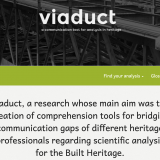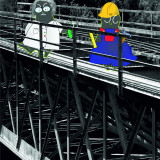VIADUCT, bridging communication gaps regarding heritage scientific analysis

- Location : Athens, Greece
- Date: 2014-2015
- Participating Countries : Belgium, Greece, Italy, Spain
- Partner Institutions : CNCPC of the Instituto Nacional de Antropologia e Historia,the FRS-F.N.R.S. and Universite de Liege
The project
Viaduct, a research whose main aim was the creation of comprehension tools for bridging communication gaps of different heritage professionals regarding scientific analysis for Built Heritage. Targeting the research onto conservation of buildings, our main objective was the categorization and explanation of the characterization analysis and of dating methods, namely the methods related to the technological processes in the creation of any construction. Of these two research method families, we will focus on 21 investigation techniques related to building materials, namely stone, CBM (Ceramic Building Materials), mortar, wood, metal (iron and lead) and the pigments most frequently used in the western world. With the aim of creating a multi-perspective handbook and a website useful for all, applying at the same time the concept of interaction in action, DIADRASIS formed a research team composed of four different professional profiles: an Archaeometrist, an Architect & Art Historian, a Chemist and a Conservator of Antiquities. These two tools are not meant to compete with the extended scientific literature on the subjects, but to become tools of communication. Viaduct Research was funded in the frame of “Scientific projects” by John S. Latsis Public Benefit Foundation.Contents
Characterization
Characterization methods applied on building materials offer complementary archaeological information related to a building site; from the steps preceding its construction, e.g. from the supply of materials to their transformation, their use in the building, their replacement, etc. All the above provide the necessary information in order to decide whether and how to proceed to a suitable restoration or conservation intervention of the building.
- chemical composition: the elements and molecules that constitute a sample.
- internal morphology: it is the form in which the elements are distributed in the structure of a material.
Identifying the chemical components or the morphology of an unknown material and comparing them to known materials can be extremely useful for:
- origin studies
- indirect dating
- manufacturing technology
- deterioration state
Dating
Dating is the preeminent step in any archaeological building study. This fundamental element not only enriches it with a chronological weight, determining its origin, its different construction phases and its evolution, it also places it within a wider historical context. All these questions can be thoroughly answered only by dating a building material or a masonry structure.
There are several methodologies which allow for a preliminary dating of historical buildings:
- typo-chronological study
- historical research
- archaeological and architectural stratigraphy
- technical analysis: It is a specific kind of typo-chronological study based on the progressive evolution of constructive techniques, which allows for dating from the constructive element itself (i.e. some Roman bricks can be dated on the basis of their seals) or from a technical achievement that it represents.
ANALYSIS included in Viaduct (alphabetical order)
- 14C
- Archaeomagnetism
- Biological Cultures
- Chromatography
- Dendrochronology
- EC
- FTIR
- Granulometry
- ICPAES/ICPMS
- IR Thermography
- NAA
- OM
- PIXE
- Porosimetry
- Raman Spectroscopy
- SEM
- TA
- TL/OSL
- UV Fluorescence
- XRD
- XRF




